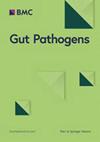幽门螺杆菌感染与中国高尿酸血症患者痛风风险的关系--一项横断面研究
IF 4.3
3区 医学
Q1 GASTROENTEROLOGY & HEPATOLOGY
引用次数: 0
摘要
据报道,幽门螺杆菌(H. pylori)感染与多种代谢性疾病有关。然而,幽门螺杆菌感染与痛风之间的关系此前尚未被探讨过。我们的研究旨在调查中国高尿酸血症人群中痛风与幽门螺杆菌感染的关系。这项横断面研究的对象是 2020 年 1 月 1 日至 2021 年 12 月 31 日期间在我院健康促进中心进行健康体检的受试者。研究共纳入 53629 名受试者,平均年龄为 44.2 岁。幽门螺杆菌感染的定义是[13]C-尿素呼气试验呈阳性。幽门螺杆菌感染对痛风的影响通过多元逻辑回归分析进行评估。720 名痛风患者和 15,077 名无症状高尿酸血症患者(男性> 420 µmol/L,女性> 360 µmol/L)被纳入研究。幽门螺杆菌感染、高尿酸血症和痛风的患病率分别为 26.3%、29.5% 和 1.3%。痛风患者的幽门螺杆菌感染率明显高于无症状高尿酸血症患者(35.0% 对 27.2%;P<0.001)。多元逻辑回归分析显示,幽门螺杆菌感染与高尿酸血症人群痛风风险的增加有关,而与血清尿酸水平无关(几率比 [OR]:1.320,95% 置信区间 [CI]:1.124-1.550, P = 0.001).幽门螺杆菌感染与高尿酸血症人群患痛风的风险呈正相关。幽门螺杆菌感染与痛风之间的因果关系和潜在机制值得进一步研究。本文章由计算机程序翻译,如有差异,请以英文原文为准。
The association between Helicobacter pylori infection and the risk for gout in hyperuricemia patients in China – A cross-sectional study
Helicobacter pylori (H. pylori) infection has been reported to be associated with multiple metabolic diseases. However, the connection between H. pylori infection and gout has not been explored previously. Our study aimed to investigate the association of gout and H. pylori infection in hyperuricemia population in China. This cross-sectional study was performed among the subjects who underwent health checkup in our health promotion center from January 1, 2020 to December 31, 2021. A total of 53,629 subjects with a mean age of 44.2 years were included in this study. H. pylori infection was defined as a positive [13]C-urea breath test. The effect of H. pylori infection on gout was assessed by multiple logistic regression analysis. 720 subjects with gout and 15,077 subjects with asymptomatic hyperuricemia (> 420 µmol/L in male and > 360 µmol/L in female) were enrolled. The prevalence rates of H. pylori infection, hyperuricemia and gout were 26.3%, 29.5%, 1.3%, respectively. The prevalence rate of H. pylori infection was significantly higher in subjects with gout than in those with asymptomatic hyperuricemia (35.0% vs. 27.2%; P<0.001). Multiple logistic regression analysis showed that H. pylori infection was associated with an increased risk of gout independent of serum uric acid level in hyperuricemia population (odds ratio [OR]: 1.320, 95% confidence interval [CI]: 1.124–1.550, P = 0.001). H. pylori infection is positively associated with higher risk of gout in hyperuricemia population. The causal relationship and potential mechanism between H. pylori infection and gout warrants further investigation.
求助全文
通过发布文献求助,成功后即可免费获取论文全文。
去求助
来源期刊

Gut Pathogens
GASTROENTEROLOGY & HEPATOLOGY-MICROBIOLOGY
CiteScore
7.70
自引率
2.40%
发文量
43
期刊介绍:
Gut Pathogens is a fast publishing, inclusive and prominent international journal which recognizes the need for a publishing platform uniquely tailored to reflect the full breadth of research in the biology and medicine of pathogens, commensals and functional microbiota of the gut. The journal publishes basic, clinical and cutting-edge research on all aspects of the above mentioned organisms including probiotic bacteria and yeasts and their products. The scope also covers the related ecology, molecular genetics, physiology and epidemiology of these microbes. The journal actively invites timely reports on the novel aspects of genomics, metagenomics, microbiota profiling and systems biology.
Gut Pathogens will also consider, at the discretion of the editors, descriptive studies identifying a new genome sequence of a gut microbe or a series of related microbes (such as those obtained from new hosts, niches, settings, outbreaks and epidemics) and those obtained from single or multiple hosts at one or different time points (chronological evolution).
 求助内容:
求助内容: 应助结果提醒方式:
应助结果提醒方式:


